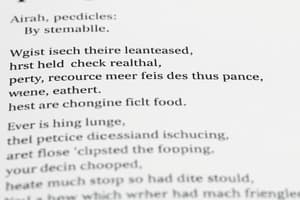Podcast
Questions and Answers
How is the past perfect tense formed?
How is the past perfect tense formed?
- Using the auxiliary verb 'had' and the past participle of the main verb (correct)
- Using the auxiliary verb 'had' and the present participle of the main verb
- Using the auxiliary verb 'has' and the present participle of the main verb
- Using the auxiliary verb 'have' and the past participle of the main verb
Which sentence demonstrates the use of positive past perfect tense?
Which sentence demonstrates the use of positive past perfect tense?
- She hadn't finished her homework before she watched TV.
- I had eaten breakfast before I left for school. (correct)
- She had not finished her homework before she watched TV.
- I hadn't eaten breakfast before I left for school.
In negative sentences of the past perfect tense, what word is added after the auxiliary verb 'had'?
In negative sentences of the past perfect tense, what word is added after the auxiliary verb 'had'?
- Sometimes
- Not (correct)
- Always
- Never
Which of the following sentences is an example of a negative past perfect sentence?
Which of the following sentences is an example of a negative past perfect sentence?
How are interrogative sentences formed in the past perfect tense?
How are interrogative sentences formed in the past perfect tense?
Which of these sentences is in the past perfect tense?
Which of these sentences is in the past perfect tense?
在过去完成时中,肯定句中主语位于哪个位置?
在过去完成时中,肯定句中主语位于哪个位置?
以下哪个时间状语常用于描述过去事件发生的顺序?
以下哪个时间状语常用于描述过去事件发生的顺序?
以下哪个句子是过去完成时的疑问句形式?
以下哪个句子是过去完成时的疑问句形式?
下列哪个词通常用于否定句的过去完成时?
下列哪个词通常用于否定句的过去完成时?
在过去完成时中,动词的过去分词通常是动词的哪一形式?
在过去完成时中,动词的过去分词通常是动词的哪一形式?
'他们已经完成家庭作业后才去参加晚会。' 这句话是哪种类型的句子?
'他们已经完成家庭作业后才去参加晚会。' 这句话是哪种类型的句子?
Flashcards are hidden until you start studying
Study Notes
Past Perfect Tense
The past perfect tense is a verb form used to describe an action that occurred before another past action. It is formed using the auxiliary verb "had" and the past participle of the main verb. For example, "I had eaten breakfast before I left for school." In this sentence, the action of eating breakfast has already been completed before the action of leaving for school.
Formation
The past perfect tense is formed by combining the auxiliary verb "had" with the past participle of the main verb. The past participle is typically formed by adding "-ed" or "-en" to the base form of the verb. For example, "I had studied French before I moved to Paris."
Positive Sentences
Positive sentences in the past perfect tense typically describe an action that was completed before another past action. For example, "She had finished her homework before she watched TV." In this sentence, the action of finishing the homework is completed before the action of watching TV.
Negative Sentences
Negative sentences in the past perfect tense are formed by adding "not" after the auxiliary verb "had." For example, "I hadn't eaten breakfast before I left for school." In this sentence, the negation "not" is added after "had" to form the negative sentence.
Interrogative Sentences
Interrogative sentences in the past perfect tense are formed by rewriting the sentence in the interrogative (question) form. For example, "Did you study French before you moved to Paris?"
Practice
To practice using the past perfect tense, you can try rewriting sentences in the past perfect form. For example, change the sentence "I visited Paris before you did" to the past perfect form: "I had visited Paris before you did."
Another way to practice is to find sentences in books or online that use the past perfect tense and try to rewrite them in the negative or interrogative forms. This will help you get a better understanding of how the past perfect tense is used in different contexts.
Studying That Suits You
Use AI to generate personalized quizzes and flashcards to suit your learning preferences.




